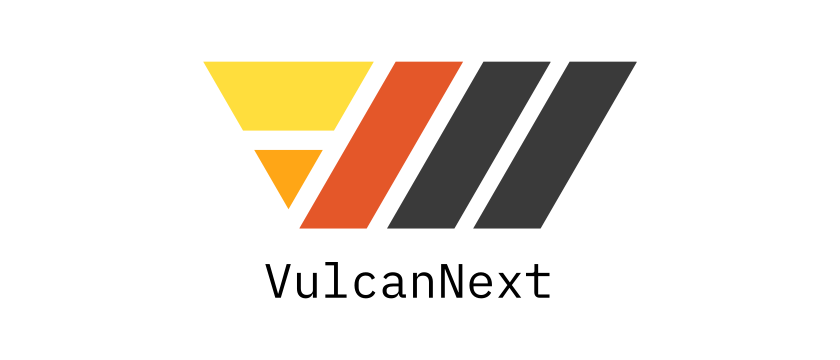Vulcan Next
Vulcan Next helps you build GraphQL-based applications with Next.js.

What's in the box?
Where Vulcan Next shines:
- B2B SaaS software, CMS, platforms
- Apps that rely a lot on CRUD operations (managing and listing data structure, like in a CMS)
- APIs that can be consumed by multiple clients (your own app but also a mobile version, data scientists, other 3rd party apps...)
Vulcan Next provides:
- A production-grade Next.js + Apollo GraphQL boilerplate.
- A GraphQL API endpoint set up with Apollo Server and a Mongo connector, so you can start coding back-end features immediately.
- Development tooling such as Cypress, Jest, Storybook... and many others.
- Schema-based helpers and hooks to quickly generate and consume your own GraphQL API
- Password based authentication with Passport
Join the Slack and meet Vulcan contributors
Join the new Discord and meet Vulcan contributors
Get started with the live tutorial
Read the introductory article on FreeCodeCamp
A word about the core team and sponsoring
You can't teach an old dog new tricks! Vulcan Next is the successor of "Vulcan.js", the Meteor framework from Sacha Greif. It inherits years of experience, with a modernized architecture that replaces Meteor by Next.js.
Vulcan Next powers the Devographics surveys State of JS, State of CSS and State of GraphQL.
Not familiar with Next.js yet? You can join the Next.js course at Human Coders from Eric Burel, 3 days to understand the inner workings of Next.js router, server and static rendering, edge middlewares and all their friends.
Want to help us building high quality boilerplates? You can sponsor Vulcan on Open Collective or reach us out for bounties and freelance work (ping us on Vulcan slack or Discord).
Install and run in 5 minutes
Pro tip: you can test Vulcan Next with zero install by cloning it on CodeSandbox.
If you prefer a local install:
git clone -b main https://github.com/VulcanJS/vulcan-next
cd vulcan-next
yarn
yarn run devOpen http://localhost:3000 in your browser. You can then access the live tutorial on http://localhost:3000/learn.
Next steps
Setup your own git repository
When creating your own application, you'll want to host the code on your own Git repository (on GitHub, BitBucket, etc.).
Point git to your own repository
Rename "origin" to "upstream", so you can use your own git repository as the main "origin", and VN official repo as "upstream".
git remote rename origin upstream
# Then do what you need to create your own origin remote
# git remote add origin <your-own-git-repository-url>Roll your own Mongo database
As a default, Vulcan Next will connect to a sample read-only database owned by LBKE. To create your own application, you'll want to use your own databse.
0. I am a Windows user (if using Mac or Linux skip to 1.)
If you use Windows, you might want to either:
-
Install Ubuntu as a dual boot (virtual machine are technically fine but way slower and could lead to a poor development experience)
-
Setup the Linux subsystem in order to be able to run Docker on Windows
-
Install MongoDB using the Windows installer
1. Run a Mongo server using Docker
It will run Mongo in your current terminal, or create and run a Mongo image if it's the first time your run the command.
Note: you should always start your database before you run the application.
yarn run start:mongoSee Docker installation instruction for Ubuntu here if you don't have Docker yet.
2. Configure your application to use your local database
In .env.development or .env.development.local use this URI for Mongo:
MONGO_URI="mongodb://localhost:27017/vulcan-next-app"You can then stop the server and start it again.
We advise to use MongoDB Compass to visualize your database content.
Update your app to the latest version of Vulcan Next
Beware: Vulcan Next is a boilerplate, the possibility to update automatically is not guaranteed. You may have to apply the updates by hand, comparing Vulcan Next latest version to your own code. Always double-check that the merge didn't break your app!.
# Get the latest version of Vulcan Next locally
git fetch upstream
# Merge to your own code (favouring your own code as a default in case of conflict)
git merge upstream/main -X oursContribute or raise an issue
This starter is read-only! Please avoid opening pull requests against it.
All developments happen in our monorepo "Vulcan NPM" here.
They support Vulcan Next and Vulcan Meteor
Contributors
This project exists thanks to all the people who contribute.
Backers
Thank you to all our backers! 🙏 [Become a backer]
Sponsors
Support this project by becoming a sponsor. Your logo will show up here with a link to your website. [Become a sponsor]
Technical supports
They give time and share knowledge to support the project.



Other cool Next stuff
- Official Apollo example from Next
- Next Right Now (a complete Next Starter, relying on Prisma cloud solutions for the backend)
- Blitz (fullstack Next without GraphQL)
- Next Antd Graphql Starter
- Next React Graphql Apollo Bootstrap
- Next advanced starter,
- Next - Mongo (no Express, no GraphQL, just Next and Mongo)
- Next and TypeScript from the maker of next-transpile-modules
- A frontend performance oriented starter
- Bison, a full-stack Next.js starter
- Nextra, a no-code site generator with Markdown (great for blogging)
- BlueLibs, a toolkit that also proposes a React starter
About Next.js
This is a Next.js project bootstrapped with create-next-app.
Learn More
To learn more about Next.js, take a look at the following resources:
- Next.js Documentation - learn about Next.js features and API.
- Learn Next.js - an interactive Next.js tutorial.
You can check out the Next.js GitHub repository - your feedback and contributions are welcome!
Deploy on Vercel
The easiest way to deploy your Next.js app is to use the Vercel Platform from the creators of Next.js.
Check out our Next.js deployment documentation for more details.